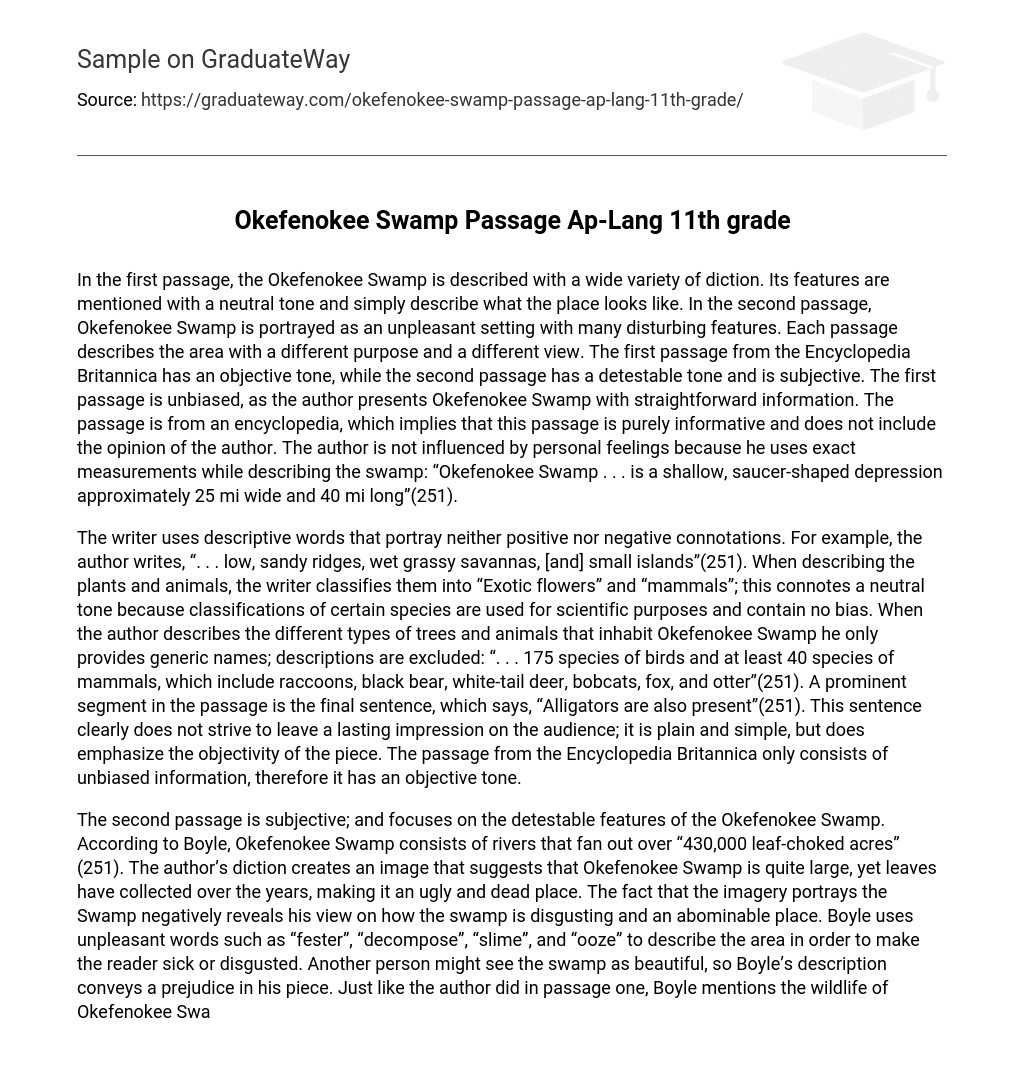In the first passage, the Okefenokee Swamp is described with a wide variety of diction. Its features are mentioned with a neutral tone and simply describe what the place looks like. In the second passage, Okefenokee Swamp is portrayed as an unpleasant setting with many disturbing features. Each passage describes the area with a different purpose and a different view. The first passage from the Encyclopedia Britannica has an objective tone, while the second passage has a detestable tone and is subjective. The first passage is unbiased, as the author presents Okefenokee Swamp with straightforward information. The passage is from an encyclopedia, which implies that this passage is purely informative and does not include the opinion of the author. The author is not influenced by personal feelings because he uses exact measurements while describing the swamp: “Okefenokee Swamp . . . is a shallow, saucer-shaped depression approximately 25 mi wide and 40 mi long”(251).
The writer uses descriptive words that portray neither positive nor negative connotations. For example, the author writes, “. . . low, sandy ridges, wet grassy savannas, [and] small islands”(251). When describing the plants and animals, the writer classifies them into “Exotic flowers” and “mammals”; this connotes a neutral tone because classifications of certain species are used for scientific purposes and contain no bias. When the author describes the different types of trees and animals that inhabit Okefenokee Swamp he only provides generic names; descriptions are excluded: “. . . 175 species of birds and at least 40 species of mammals, which include raccoons, black bear, white-tail deer, bobcats, fox, and otter”(251). A prominent segment in the passage is the final sentence, which says, “Alligators are also present”(251). This sentence clearly does not strive to leave a lasting impression on the audience; it is plain and simple, but does emphasize the objectivity of the piece. The passage from the Encyclopedia Britannica only consists of unbiased information, therefore it has an objective tone.
The second passage is subjective; and focuses on the detestable features of the Okefenokee Swamp. According to Boyle, Okefenokee Swamp consists of rivers that fan out over “430,000 leaf-choked acres” (251). The author’s diction creates an image that suggests that Okefenokee Swamp is quite large, yet leaves have collected over the years, making it an ugly and dead place. The fact that the imagery portrays the Swamp negatively reveals his view on how the swamp is disgusting and an abominable place. Boyle uses unpleasant words such as “fester”, “decompose”, “slime”, and “ooze” to describe the area in order to make the reader sick or disgusted. Another person might see the swamp as beautiful, so Boyle’s description conveys a prejudice in his piece. Just like the author did in passage one, Boyle mentions the wildlife of Okefenokee Swamp, yet he is very precise about which species he talks about: “[f]our hundred and thirty thousand acres of stinging, biting, and boring insects” (251). In this part of the passage, Boyle focuses solely on insects, which are repulsive to most humans. In order to emphasize how nasty these creatures are he mentions how they sting, bite, and bore into humans, making a visit there undesirable. Although he provides information about the swamp, Boyle adds his own opinion making the entire passage subjective.
When Boyle describes the animals such as reptiles, amphibians, and fish, he states that they are “equipped with beaks, talons, claws, teeth, stingers, and fangs” (251). In this excerpt the author clearly wants to show that the animals of the swamp are primitive and still need to hunt and brutally slaughter prey to feed themselves. Any humane reader would see this as unwanted and repulsive. Boyle also focuses on the blood sucking creatures of the swamp, parasites: “. . . ticks, mites, hookworms, and paramecia that exist only to compound the misery of life” (251). The idea of being surrounded by parasites causes the reader to have a sense of revulsion towards the swamp. Near the end of the passage Boyle adds some humor to portray how revolting the swamp animals truly are: “they scratch and stink and sniff at themselves”(251). To finally sum up his passage Boyle describes Okefenokee Swamp in two words a “hellish zoo”. This ultimately reveals the author’s feelings of the swamp and the subjective aspect of the second passage, as well as the abominable tone.
Both passages contain information of the swamp but each conveys a different tone with the use of its descriptive words and imagery. Boyle leans towards using words that create a sense of disgust in the reader, which simultaneously reveals his own opinion. Meanwhile the first passage from the Encyclopedia Britannica focuses on the use of descriptive words with neutral connotations in order to inform the reader of the swamp and allow him/her to view it as it truly is.





